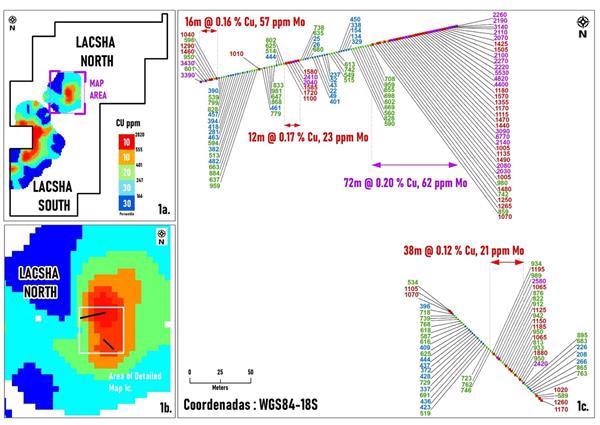Latin Metals Inc., a mineral exploration company acquiring a diversified portfolio of assets in South America, reports the results of continuous rock chip channeling from the Lacsha North target area.
 Lascha North continuous rock chip sampling showing copper grades and selected composite rock chip intercepts. Image Credit: Latin Metals Inc.
Lascha North continuous rock chip sampling showing copper grades and selected composite rock chip intercepts. Image Credit: Latin Metals Inc.
The results reveal wide and consistent copper and molybdenum mineralization, which includes 72 m grading 0.2% copper and 62 ppm molybdenum. Here, the copper values range from 742 ppm copper to 6,770 ppm (0.68%) copper.
These positive outcomes add more to the results that arrived recently from the Lacsha South target area. Comparable mineralization was observed in this region, which was reported in the previous release on August 16th, 2021. This includes 30 m grading 0.22% copper and 76 ppm molybdenum.
These results further expand the mineralized footprint at Lacsha, which indicate two large and distinct mineralized centers exposed at surface. We continue to be of the view that these zones could represent the upper weathered portions of potentially large porphyry system. In the past week, ground magnetic surveying has been completed over both Lacsha North and Lacsha South, with results expected in due course.
Keith Henderson, President and CEO, Latin Metals Inc.
Individual samples were obtained at intervals of 2 m. It is feasible to quantify the actual thickness from the existing level of available data. However, sample orientation has been designed to be as representative as possible. The wholly-owned 4000-ha Lascha project is one of the three large-scale copper exploration projects being explored in Peru.
Coastal Copper Belt
The coastal copper belt in the Cretaceous belt in Peru is home to a range of deposit types, including Epithermal, Porphyry, VMS and IOCG. The Lacsha copper-molybdenum and Auquis copper-gold projects wholly owned by Latin Metals are both situated in the Northern Lima-Ica section of the coastal belt.
QA/QC
The work program at Lacsha was developed and monitored by Latin Metals’ Exploration Manager Eduardo Leon. Leon was responsible for the quality control/quality assurance program.
On-site personnel at the job dedicatedly collect and track samples, which are then security sealed before transporting them to the ALS laboratory in Lima. Samples used for the results described here are prepared and studied by multi-element analysis with an inductively coupled mass spectrometer in accordance with the industry standards.